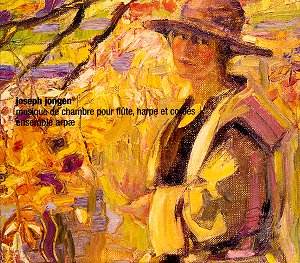Jongenís large and varied output includes a
lot of chamber music in almost all forms and for various instrumental
combinations. One of the finest examples of his refined music
making is the lovely Concert à cinq Op.71
of 1923 for flute, harp and string trio. Interestingly enough,
another wonderful chamber work of his, the colourful Rhapsody
Op.70 (piano and wind quintet) was written in 1922. Both
are perfect examples of Jongenís impressionistic writing, and
both are free fantasies in which the composerís imagination effortlessly
shines throughout. Contrary to the Rhapsodyís multi-sectional
single-movement structure, the Concert à cinq
is in three movements in the fairly traditional fast-slow-fast
pattern. The music is quintessentially Jongen in its formal clarity,
harmonic refinement and seamless melodic flow, the whole tinged
with healthy earthiness. The opening Décidé,
roughly in condensed sonata form, is followed by a beautifully
lyrical rêverie. This lovely work ends with a vigorous,
jig-like Finale of great charm. Incidentally, it was the very
first work written for the French ensemble Quintette instrumental
Pierre Jamet which performed it repeatedly and for which several
French composers (Koechlin, Schmitt, Roussel and Ropartz, to name
but a few) have also composed similar works. The Ensemble Arpae
grouping several brilliant young Belgian musicians has already
recorded the piece, which they obviously love, for another Belgian
label (Phaedra 92012, published in 1996, with quintets by Pelemans,
Westerlinck and Daniel-Lesur).
The somewhat later Sonate-duo Op.109,
completed in 1938, is a major work that has remained unheard for
too many long years and is the major discovery here. Though quite
probably modelled on Ravelís Sonate pour violon et violoncelle,
it nevertheless is a quite different piece of music. Jongen roughly
devised it as a theme and variations, full of brilliant string
writing and often intricately contrapuntal, sometimes paying homage
to Ysaÿe whose sonatas for solo violin are at times brought
to mind. However, as is often the case in Jongenís best music,
the formal aspect of the music neither obscures its expressive
strength nor excludes flights of instrumental fancy of great virtuosity.
Jongen composed two sets of Pièces
en trio. The earlier one, the present Deux pièces
en trio Op.80 for flute, cello and harp, was composed
in 1925 whereas the other set Deux pièces en trio
Op.95 of 1931 is for piano trio and has already been recorded
repeatedly over the last few years. This attractive diptych consists
of a slow, dreamy first movement followed by a lively dancing
second one. All Jongen hallmarks are displayed to the full in
this delightful piece of the composerís mature years.
Jongen loved the viola and composed a number
of substantial works for it, including the substantial Suite
pour orchestre et alto principal Op.48 recorded many years
ago during the LP era but shamefully neglected since then. Here,
we have another rarity, the Adagio Op.22 No.1 for
violin and viola, a most welcome short contrapuntal study superbly
written for the instruments. (Incidentally, Op.22 No.2
is a short one-movement sonata for solo violin which I have never
heard.)
This most attractive release also includes one
of Jongenís most popular works, the beautiful Danse lente
Op.56 for flute and harp composed in 1917 in England where
Jongen and his family stayed during World War I. (It may also
be played as a more conventional duo for flute and piano, available
on Cyprès CYP 4615, to be reviewed shortly.)
This enjoyable release is another most welcome
addition to Jongenís expanding discography. Several mature works
of great beauty in excellent, loving and dedicated performances
that serve the music well. Jongenís beautifully crafted music
is, at long last, being given its due, and there is much more
to come.
Hubert Culot

